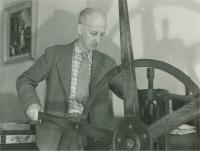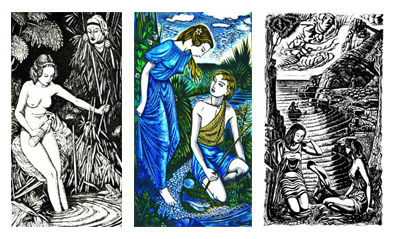John Buckland-Wright
Born: 1897
 |
In
the 1930's, 1940's and early 1950's three artists did a great deal to launch
British engraving into the exciting waters of contemporary European art: the
New Zealander John Buckland Wright and two Englishmen William Hayter and
Anthony Gross. They all had French attachments and were quite independent of
the influences of earlier and highly successful schools of British engraving.
Buckland Wright helped Hayter to found his famous Atelier 17 in Paris. At this
workshop, in which artists experimented at novel methods of printmaking, JBW
(as became known by his initials) worked with artists such as Matisse, Chagall,
Picasso, Miró, Dali. Later when teaching at the Camberwell and Slade Schools of
Art, he was able to communicate to his pupils his experience of how these
artists worked.
JBW's work is characterized by
the portrayal of the sensuous nude, in which the female form is depicted with
grace and charm. The source for his artistic expression has its origin in his
experiences during the First World War. Having joined the Scottish Ambulance
Service, he was seconded to the French Army at Verdun, the sector in which the
French suffered the greatest devastation during the First World War. There he
witnessed harrowing scenes of human devastation while rescuing wounded and
dying men from the front line trenches. Following the war, JBW found relief in
drawing the female figure that incorporated the romantic ideal of Greek
philosophy into the very essence of the emotional expression of his work.
Through his
art he was able to come to terms with the horrors he had experienced during the
war and to restore unity and tranquillity to the devastated landscapes, to
repair the damage that war had wrought on his love of nature. Once more he
would fill his world with beauty of a timeless quality he had experienced in
the gardens and countryside of New Zealand and England. He found his emotional
renewal through his art. It was in this way that he was able to express his
fundamental belief in the renewal of life and of the human spirit and to
rediscover the joy he felt as a young man in nature's soothing beauty.

View work by John Buckland-Wright >>
Show printable version of this page (opens in new window) >>